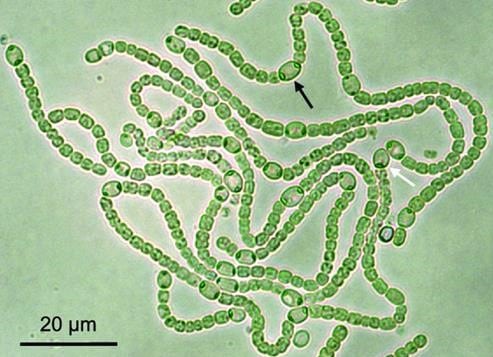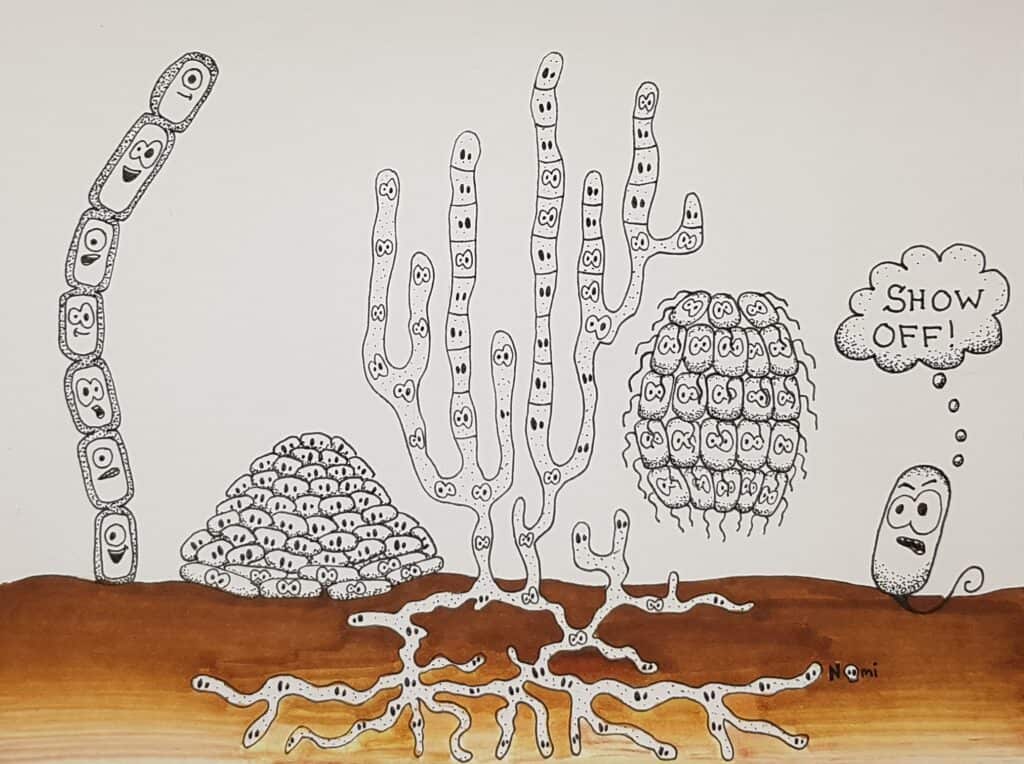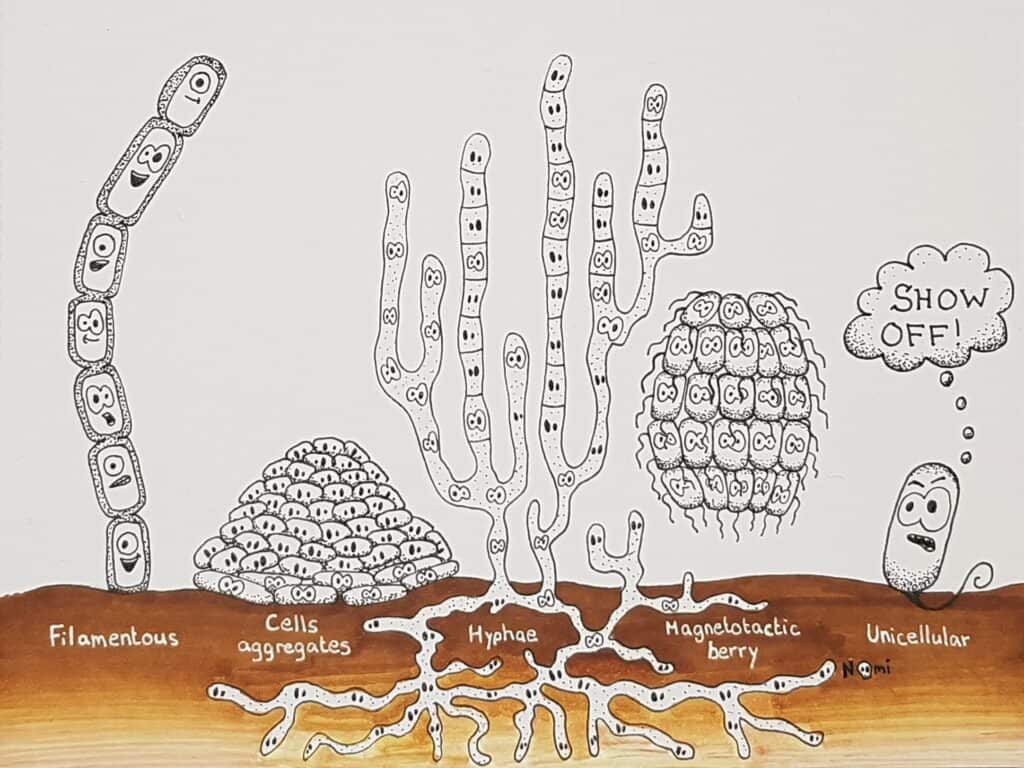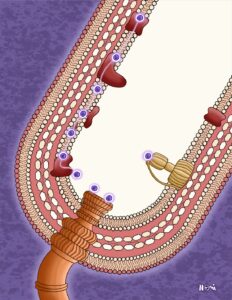When speaking of multicellular bacteria, probably a few questions come to your mind.
Do bacteria always only live in one form; either they are single cells or multicellular?
How do we distinguish between unicellular and multicellular bacteria?
Which advantage do bacteria gain from sticking together and forming multicellular organisms?
What are some examples of multicellular bacteria?
In this article, we will answer exactly these questions!
Let’s dig in!
What makes multicellular bacteria?
Scientists define multicellularity as a form of “biological organisation in which a permanent cell aggregate exhibits an activity more complex than that of the individual cells“.
This means that multicellular bacteria are only present in their multicellular forms. True multicellular organisms cannot go back being single-celled.
Hence, bacterial biofilms are no true multicellular organisms. Bacteria can decide between these two lifestyles; they actively produce the biofilm when needed and they break it off and become single cells again.
Also, a bacterial colony in a petri dish is not a multicellular organism. In a colony, a bunch of bacterial cells grow on top of each other. But the cells in the colony are not organised and they do not function in an organised manner.
Multicellular bacteria are organised
The difference here lies in the term biological organisation. Multicellular bacteria are organised due to two different concepts:
They work in an organised manner; bacteria within the multicellular organism need to communicate with each other. Thanks to communication, every bacterium within the organism knows what is going on, so it can react in an organised manner.
Just as when your stomach is empty, it tells your brain that you’re hungry and you react accordingly by eating. Your stomach and your brain are communicating with each other.
The second way to organise multicellular bacteria is by using different functions to advance the whole organism. Within a multicellular organism, some bacteria undergo a process called cell differentiation. Cell differentiation is what makes a human stem cell develop into a skin cell or a blood cell. And this skin or blood cell has more specialised functions than the stem cell that it was before.
The same can happen in multicellular bacteria. Some bacteria develop into specialised cells. These specialised bacterial cells have functions that other cells (or the single version of the bacteria) do not have.
Now, some of the bacteria have additional functions or abilities. And thus, the whole multicellular organism gains new bacterial superpowers that can advance the organism.
Why do bacteria form multicellular organisms?
Here, evolution plays a massive role since multicellularity has so many advantages.
In multicellular organisms, the labour is divided. Just as it is easier for you and your co-workers to work in a team with everyone doing what they are best at. With bacterial cells taking on new functions through cell differentiation, the whole organism profits.
Another advantage is that when bacteria cluster together, they can protect their core. And some multicellular bacteria keep their spores within the core for protection. Like this, their most vulnerable members are protected.
Also, multicellular bacteria are generally bigger than single bacterial cells. This makes it more difficult for attackers to prey on this organism. And we know how much bacterial warfare is going on in the microbial world.
What are some cool examples of multicellular bacteria?
Researchers have not found that many yet. But those multicellular bacteria, that they started to investigate, are pretty cool.
Well, that’s what I think, but see for yourselves.
Multicellularity in chains: filamentous cyanobacteria
Filamentous cyanobacteria are Earth’s oldest multicellular organisms. And thanks to them, we have all this precious oxygen on our planet.
Some cyanobacteria form long chains, so-called filaments. In such an organisation, the whole chain of cyanobacteria is surrounded by one common outer membrane. This means, that all cyanobacteria cells within the filament share one periplasm. And they use this periplasm to communicate with each other and exchange nutrients.

Also, filamentous cyanobacteria like the Anabaena species can undergo cell differentiation. In the picture above, you can see a chain of Anabaena cells. Some cells are smaller, which are the undifferentiated cells, and some are bigger blobs.
The normal-sized cells have photosystems and they perform photosynthesis to produce oxygen.
But when cyanobacteria do not have enough nitrogen, they start to differentiate into those bigger cells, so-called heterocysts. And these heterocysts are now able to fix nitrogen. This helps the organism with its nitrogen limitation.
The reason why Anabaena needs these two cell types is because the chemical processes of oxygen production and nitrogen fixation interfere with each other. They can not happen within one cell, which is why cyanobacteria need to have a different cell type for each process.
In the end, the cells share the produced oxygen and the fixed nitrogen with the whole filament. So everyone is happy with this arrangement.
Multicellular bacteria as electricity producers: cable bacteria
Cable bacteria form – similarly to cyanobacteria – long filaments that are surrounded by one common outer membrane. And they use this arrangement to transport electrons and conduct electricity.

We talked about multicellular cable bacteria in detail in the article Cable bacteria – unusual microbes conducting electricity. Head there to read about this special kind of multicellular bacteria.
Multicellular organisms in cell aggregates: Myxobacteria
Some bacteria, like the well-characterised Myxobacteria, can form huge cell aggregates of up to 100’000 cells. These cell aggregates are called fruiting bodies and their main function is to feed and transport their spores.

The spores have a special place within the Myxococcus fruiting body: They are kept at the core of the fruiting body. Here, they are safe and protected from the surrounding.
Interestingly, myxobacteria are also known as wolf-pack predators, because of the way they attack their preys. They kill their preys by launching a massive attack and secreting lethal bacterial toxins. This kills the prey instantly and the whole fruiting body can feed on the prey.
Multicellular organisms forming hyphae networks: Streptomyces bacteria
Streptomyces bacteria develop a complex network of hyphae within the soil. With this network, Streptomyces bacteria can branch into different directions and elongate the branch tips.

Within the branches, some hyphae within the soil have secluded compartments with walls to separate them from the rest of the network. Yet, Streptomyces uses the hyphae to transport nutrients and chemicals and to communicate.
But when nutrients are missing, the branches grow out of the soil and into the air. Here, they form spores and produce geosmin and antibiotics. This geosmin attracts insects that distribute the spores in the environment.
Plus, by producing antibiotics, Streptomyces tries to kill those microbes that want to eat the spores.
The superhero of multicellularity: Magnetotactic multicellular prokaryotes
Ever since I heard about these bacteria, they became my favourites. And not only because these multicellular bacteria cannot even survive as single cells.
All cells within the magnetic berry are connected to a common core. On the outside of the berry, bacteria have flagella.

And because many of these bacteria assemble together and each one has several flagella, the whole berry is basically covered in bacterial flagella. When all of these flagella start rotating together, the whole berry becomes incredibly fast.
The second feature is, that these magnetotactic bacteria sense the Earth’s magnetic field lines thanks to their magnetosomes. Hence, this magnetotactic superorganism is even more sensitive to the Earth’s magnetic field, which gives it probably even more superpowers.
Lastly, the multicellular magnetotactic bacteria respond to blue light and swim away from it. This is a completely new bacterial ability and researchers are still not sure why these bacteria do that.
Unfortunately, we do not know much about these fascinating organisms, because they are incredibly difficult to grow in the lab. Until now, researchers could only image these bacteria from environmental samples as they still do not know what these bacteria need to survive in the lab.
Multicellular bacteria – an advanced lifestyle
As we have seen in this article, bacteria can grow either as single cells or as multicellular organisms.

By teaming up with their sibling cells, multicellular bacteria gain new superpowers, they can spread out and protect their weakest team members.
From an evolutionary point of view, forming multicellular organisms was a super important step. Only thanks to this, highly-developed animals with all their different cells and organs could develop.








